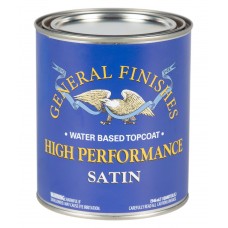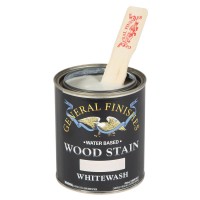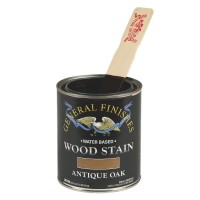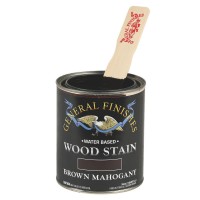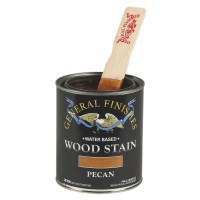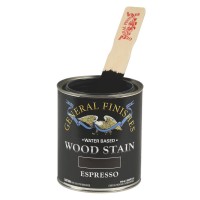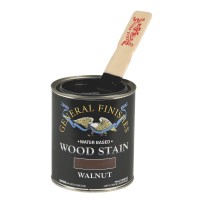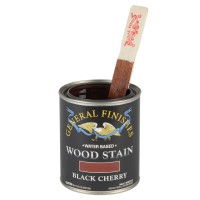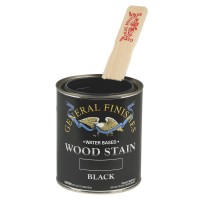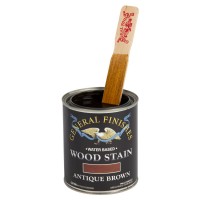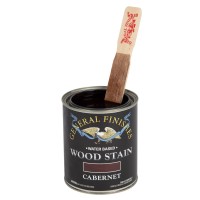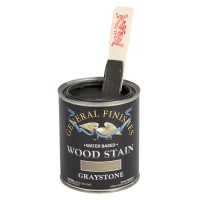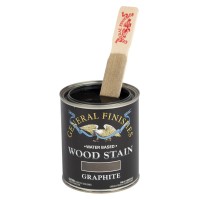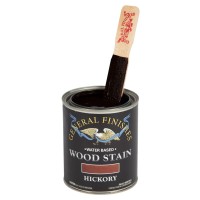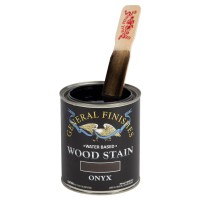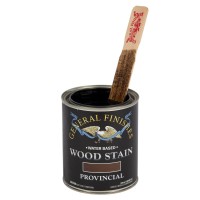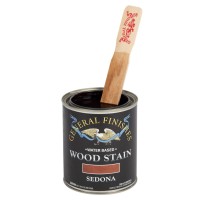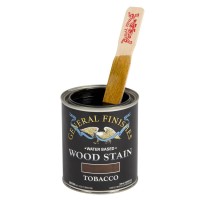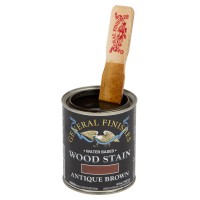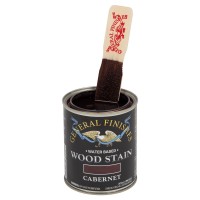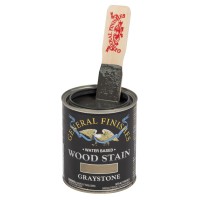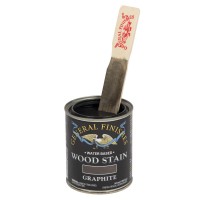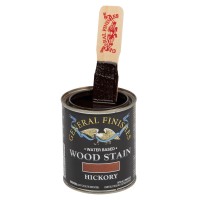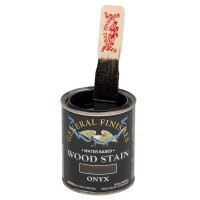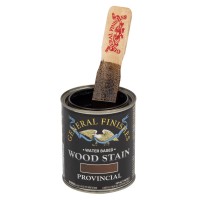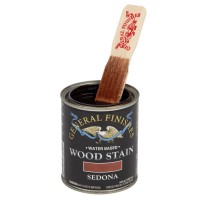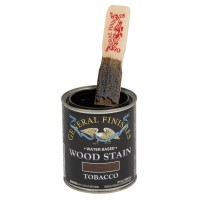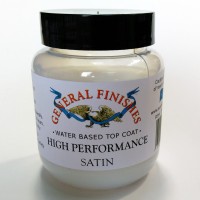High Performance Satin - 473ml
High Performance Top Coat is an excellent crystal clear durable top coat that can be brushed or spray applied.
Winner of Fine Woodworking's "Best Overall Choice Award," High Performance Topcoat was voted as the hardest, most durable consumer polyurethane topcoat.
Need some inspiration? Visit the General Finishes Design Center or Pinterest Board for furniture topcoat ideas.
VOC (EU): 40 g/L
FAQ
What is the difference between Flat Out Flat and High Performance Topcoats?
Flat Out Flat is a matte water based topcoat with a velvety feel and was developed as a durable alternative to our Satin Wax. Choose this product if you want a finish that looks more like wax and your project will not require high use. Like wax, it dries softer to the touch than High Performance when completely cured, and it will show more marring and fingerprints. Flat Out Flat is made with a stable self cross-linking acrylic instead of urethane.
High Performance is urethane based and contains less matting agents which result in a slightly harder finish. For that reason, High Performance is the best choice for high use areas such as table tops and kitchen cabinets. Both topcoats have similar water resistance, but High Performance offers greater clarity.
Use with Oil Based Finishes: Let oil-based finishes dry for 72 hours before applying High Performance or Flat Out Flat top coat.
Why Did the Finish On My Piece Become Cloudy After Top-Coating Milk Paint with High Performance?
The term for a cloudy, milky appearance in the finish is Blush. There are three causes:
- The most common reason is an incompatible stain. For example, using a water-based topcoat over an oil-based based stain. When the top coat is applied, the oil in the stain seeps up through the finish and reacts with the acrylic causing a chemical blush. To prevent this, either use a quick-drying water-based stain or allow the oil-based stain to dry for 72 hours. You can also seal an oil-based stain with a coat of lacquer sealer to provide a barrier between the oil and the acrylic.
- Another cause for blushing is high humidity. Applying a water-based finish in humidities of over 75% may cause blushing because moisture becomes trapped beneath the finish and cannot evaporate. You can prevent this condition by increasing air movement in the finishing area with a fan. All water needs to evaporate is sufficient air movement. You can also improve drying conditions by increasing the temperature in the drying area.
- Another common cause is a wet object or a water spill left two long on the surface. In most cases, the white mark will recover and fade within an hour if the spill is cleaned up in a timely manner. If the water has been sitting on that area for an extended period of time then it might not be able to bounce back. To fix this, the surface needs to be scuffed and sanded first. Second, we recommend applying a sanding sealer to protect the top. Sanding sealer has a larger resin particle, so it will provide a better build for the next sanding step. Then finish with your topcoat.
What is the difference between professional Enduro Clear Poly and High Performance Topcoat?
Enduro Clear Poly is designed for professionals that routinely spray their finishes. High Performance is formulated for the retail market so it can be sprayed or hand applied.
- Enduro Clear Poly is slightly more durable than High Performance in the categories of wear, water, and chemical resistance.
- Even though Enduro Clear poly is more durable and more water resistant than High Performance, High Performance is extremely durable and also recommended for high-use surfaces like kitchen cabinets and table tops.
- Both products can be sprayed
- High Performance can also be applied by hand with a foam/bristle brush.
- Clear Poly is an Acrylic Urethane and High Performance is a Urethane/Acrylic Blend.
- High Performance is sold in 473ml, 946ml & 3.785 litre, Clear Poly is 3.785 litre, and - by special order - 18.925 litre pails and 3,940 litre drums.
How Do I Correct Color Lift when Applying High Performance Over GF Water Based Dye Stain?
It is normal to see a bit of stain on the brush when applying the first coat of topcoat. Topcoats often pull a bit of colour on the first pass, but good preparation will minimise this.
To prepare open grains woods such as raw oak for a water-based stain, we recommend sanding with 180-grit followed by no more than 220-grit sandpaper.
300-grit or 400-grit sandpaper is too fine for preparing raw wood. Too fine of a grit changes the wood from a porous surface to one that is too smooth to absorb the stain, which causes the first top coat application to pull excessive color (it is like trying to apply stain to glass).
There is always a small amount of color pull when using water-based stains, but the smooth surface escalates this condition. This was evident in the areas that you used the brush to remove excess topcoat.
Here are some options to try. Always test a small area before proceeding with your entire project.
- TONING: Lightly sand the light areas with a 220-grit sanding foam pad to open up the pores of the wood. Create a toning mix of 10-20% Dye Stain to 80-90% topcoat. Using a small brush, apply this mix over the light areas to blend with the darker areas. Let this dry 3-4 hours. Then apply another coat of the mix over the entire surface. If this is successful, then apply 2-3 coats of the topcoat.
- GLAZING: Glaze the light areas. This will change the look of your doors but is an easier remedy.
- START OVER: Optimally, you should sand down to bare wood and start over with this prep sanding schedule indicated able. You can apply the Dye Stain directly to the wood, or mix in 10% topcoat to help lock in the colour.
Can I use a steam mop on floors finished with High Performance topcoat?
Floors sealed with High Performance Top Coat can be cleaned with Bona floor cleaning system or a similar product. We do not recommend using a steam mop because steam can damage the wood.
How Do I Buff Out High Performance Water Based Topcoat to a High Gloss?
There are several techniques by Jeff Jewitt of Homestead Finishing Products:
DRY BUFF WITH MIRKA ROYAL MICRO PAPER.
Using Mirka Royal Micro sandpaper, always start with 1500-grit sandpaper. Begin with a small area, make 2-3 passes, then evaluate results. Go to a heavier grit if surface irregularities are not fully removed. Finish with 1500-grit paper.
DRY/WET BUFF WITH ABRALON POLISHING DISCS.
Start by dry sanding with Abralon 2000-grit, and then 4000-grit. Start slowly, monitor to see if buildup is occurring. A large sized table might take 5-25 sheets of paper. If needed, lubricate by moistening with General Finishes Satin Finishing Wax, mineral spirits, or naphtha. Never use water as a lubricant. If lubricated, one sheet of 1000-grit or 1500-grit should do the entire table.
BUFFING/POLISHING WITH PRESTA POLISHING KITS.
Spray Presta polish on buffing pad stuff to lubricate the pad. Apply a quarter-sized dab of polish to sand one section. Spread with pad. Continue section by section. Mist buffing pad with Presta lubricating material when it gets too dry. You should be able to use a buffing pad on 10-20 tables before washing and reusing. When done, mist entire surface with and buff with a micro-cloth to remove splatter
NOTE: Never wet sand a water-based finish.
How Can I Tell if a Water Based Topcoat is Dry?
If the finish feels cool to the touch, it's not ready. When you can sand it to a dry powder, it is ready for the next coat. Dry times will be longer if it is raining, cold, or humid. When in doubt, waiting longer is always better.
What is the Best Applicator to use for Milk Paint and Water Based Topcoat?
Either bristle or foam brushes will work well with Milk Paint and Top Coat. You might use several types of brushes for a project.
For example:
- We like to use a synthetic brush (which loads up more paint) to get Milk Paint on the surface, and then use a water or Extender dampened foam brush to smooth out the finish.
- Synthetic bristle brushes are particularly helpful on vertical and detailed surfaces but they can produce subtle texture.
- Foam brushes tend to produce a smoother finish which can be particularly helpful on flat horizontal surfaces.
- Pad Applicators or paint rollers are also helpful on larger horizontal surfaces such as a table top.
For those who don't want to invest in several brushes, the foam brush is our recommendation.
The very best application method is spraying.
Step 1: Preparation
All wood projects require preparation sanding, and all existing finishes require prep cleaning and sanding. If you skip this critical step, your finish may fail.
Preparation for Raw Wood or Raw Wood Projects That Are to be Stained
- Sanding Schedule: 120-grit followed by 150- or 220-grit sandpaper.
- Remove dust with a vacuum, compressed air, an oil-free tack cloth or a water-dampened rag.
- Let dry completely before applying GF product.
- Do not over-sand with fine-grit sandpapers; this will close and seal the wood grain, preventing ideal colour absorption.
- Do NOT use steel wool with water-based finishes; the particles will get trapped in the finish and rust.
Preparation for Projects with an Existing Finish (Sealed Surface)
For high-use areas with heavy grime build-up and oil from hands, give your project a deeper cleaning.
- Scuff clean with a Scotch Brite pad and a 50:50 mix of denatured alcohol and water. Dry 1-2 hours. Avoid cleaning with products containing phosphates (salt), which can linger in the substrate and produce a white haze. If your project requires a deeper cleaning, see Power Prep Cleaning Highly Used Existing Finishes below.
- Sand lightly with a fine-grade (220-320) foam sanding pad.
- Remove dust with a vacuum, compressed air, an oil-free tack cloth or a water-dampened rag.
- Let dry completely before applying General Finishes product.
Power Prep Cleaning Highly Used Existing Finishes
For high-use areas such as kitchen cabinets or table tops with heavy grime build-up and oil from hands, give your project a "Power" clean.
- Scrub clean with a detergent, using a Scotch Brite pad.
- Rinse well with water.
- Scrub clean with a Scotch Brite pad and a 50:50 mix of denatured alcohol and water. Dry 1-2 hours.
- Sand lightly with a fine-grade (220-320) foam sanding pad.
- Remove dust with a vacuum, compressed air, an oil-free tack cloth or a water-dampened rag.
- Let dry completely before applying General Finishes product.
Alternative Cleaning Solutions For Existing Finishes (Not as aggressive or effective as denatured alcohol; requires rinsing.)
- 50:50 mix of bleach and water
- 50:50 mix of vinegar and water
- Mineral spirits can be used when working with water-based products, but only if the surface is thoroughly rinsed and allowed to dry for 72 hours.
- If you use with products containing phosphates (salt), which can linger in the substrate and produce a white haze, be sure to rinse thoroughly.
Step 2: How To Apply General Finishes High Performance
CAUTION: Do NOT use GF High Performance or any other clear coat, over white or light paints such as GF Milk Paint, or GF White Poly as it may cause yellowing. Any clear coat can become reactive over wood substrates or existing finishes causing tannin, stain or dye bleed-through. All of GF's White Paints, brushable or spray versions, do NOT require a topcoat.
General Finishes High Performance Water Based Topcoat Application Steps
- Stir topcoat to reincorporate solids that have settled to the bottom of the can before and throughout the application process.
- If desired, thin with up to 15% distilled water or General Finishes Extender. Start by adding 5% in increments until you reach the desired consistency. GF Extender will improve flow and leveling and increase open time, which is helpful in dry climates.
- Apply 3 coats of High Performance. More coats will not improve durability.
- Hand application: Apply a liberal amount of product using a synthetic bristle brush, foam brush, pad applicator, or roller. Avoid pressure and excessive back brushing. Brush along the wood grain using smooth, even strokes with light lap marks. Let lap marks dry - they WILL tighten down.
- Spray application: Before spraying, strain topcoat through a fine-mesh filter. Spray wet films at 3-5-mil thickness. HVLP: 1.1mm-1.3mm spray tip, medium air cap. Verify tip sizes with your equipment supplier. See our general guide for spray tip sizes. Keep your gun at a 90° angle, 15-20cm from the surface. On large, flat areas, use wet, even patterns 15-20cm wide. For narrow surfaces, reduce the fan pattern to 5-8cm wide to reduce overspray. Overlap each pass 25% to conceal lines. Wear a full filter respirator (NIOSH/MSHA-approved) and work in a ventilated space. Read here for more information on spraying techniques.
- Face frames and drawers on cabinets: High Performance can be successfully applied by hand to cabinet face frames or edges with a brush, pad or small, cabinet-specific roller.
- If a faster build is desired over raw wood, use General Finishes Sanding Sealer for the first coat, followed by 2 coats of High Performance Topcoat.
- Dry 2+ hours between coats in ideal conditions: 20°C; 50-70% humidity. Be sure to allow adequate dry time. You can tell if a water-based finish is dry if it forms a powder when lightly sanded with a fine-grade (220-320) foam sanding pad. If in doubt, wait longer. Rushing the dry time can cause "blush," which is clouding in the finish due to moisture trapped between the layers. Increase dry time if:
- Humidity is over 80%
- 3+ coats are applied
- Thick coats are applied
- Applying over an existing sealed finish
- Applying over products from other brands
- Layering General Finishes water- and oil-based products:
- Water over oil: Let oil-based products dry 72+hr before applying water-based products
- Oil over water: Let water-based products dry 24+hr before applying oil-based products
- To accelerate dry time in humid conditions, add General Finishes Accelerator and work in a space with good ventilation and air movement. If you decide to re-coat before the recommended time, test dryness.
- Finish sand between coats with a fine-grade (220-320) foam sanding pad to improve smoothness and adhesion.
- Remove dust with a vacuum, compressed air, an oil-free tack cloth or a water-dampened rag.
Cure Time
Water-based finishes cure and harden for full use after 21 days in ideal conditions. Avoid placing heavy objects on surfaces that have not completely cured. Treat gently, and do not clean with commercial products during the curing period.
Tips to prevent streaking during hand-application:
- Use a semi-gloss or gloss sheen with little to no flatting agents. The more flatting agents, the more likely a topcoat will streak when applied.
- To avoid streaking with the flatter sheens, apply a liberal amount of product and avoid using pressure and back-brushing. Wipe along the wood grain using smooth, even strokes. For large surfaces, apply topcoat with a large applicator, such as a paint pad.
- Remove any streaks that occur by buffing with fine-grade (220-320) sanding pad, or sanding well and re-coating.
- For the smoothest result, apply with a spray gun.
Mixing Sheens
You mix can High Performance Topcoat sheens to adjust your sheen. For example, you can mix High Performace Flat and High Performance Gloss to obtain a different sheen.
Warning: Do not use water-based products with Linseed Oils or Danish Oils
Yellowing & Clear Topcoat
As is true of most "water-white" topcoats, General Finishes water-based topcoats dry clear over non-reactive substrates, such as plastic or metal, except General Finishes Enduro VAR, which ambers. When white paint sealed with a water-white topcoat is applied to something as unpredictable as wood, all bets are off and the reason for yellowing is often unknown. It can be caused by topcoat activating tannins in raw wood or aniline dyes, stains, or contaminants in a pre-existing finish. This is most evident when using BRIGHT WHITE paint and most prevalent in sculpted details of furniture where the topcoat can collect, intensifying colour change to an unacceptable level.
There is no reliable way to predict whether yellowing will occur and to what degree. Every existing finish is different and we rarely know the finishing provenance on an existing piece. Every tree is different and every piece of wood is unique. Raw wood can bleed tannins immediately after the topcoat dries or months later with seasonal temperature changes. Oak, pine, mahogany, and douglas fir are particularly prone to bleed-through.
Summary
- Whites have a lower “hide” quality and are more transparent than most other colors. Nearly all bright whites require additional coats to achieve the desired colour and minimize colour variation. This can increase the cost of paint finishing. Always include a clause in your contracts addressing the need for additional coats to achieve coverage.
- All bright white paint will yellow slightly with time, with or without topcoat. You have probably tried to touch up white woodwork in your home after several years and noticed the new paint is brighter.
- The underlying finish or wood species can affect the final colour of light paint.
- Details and inside corners are difficult to cover with any paint colour, but it tends to be more noticeable with whites. This is a naturally occurring phenomenon in paint application and does not necessarily constitute a defect in the paint finish or your technique.
- The more porous the paint, such as General Finishes Chalk Style Paint, the more likely that yellowing will occur. The topcoat is seeping through the spaces caused by the larger particles of filler that give Chalk Style Paints their texture.
Tips to Prevent Yellowing
- If it is a low-use project, use a premium white paint that is self-sealing and does not require a topcoat. A clear topcoat is not required on General Finishes Milk Paint for increased durability, as it is a self-sealing, exterior-rated coating with high durability and chemical and water resistance. However, topcoats do provide a smooth surface that is easier to clean and boosts durability for high-use projects, such as tabletops and kitchen cabinets.
- Use a professional spray such as General Finishes Enduro White Poly. It has "increased topcoat properties," is a standalone finish when 3 coats are applied, and does not require sealing with a topcoat.
- We recommend using General Finishes Stain Blocker, an engineered chemical barrier, to prevent persistent bleed-through for interior-use projects.
- Stain Blocker does not adhere to melamine cabinet veneers.
- Stain Blocker cannot be tinted.
- Always test your project's ENTIRE finishing schedule (from cleaning to topcoat) on an inside door or a more hidden area of the piece. This will not help if the yellowing occurs later, but at least you will know if there is an immediate problem.
- Avoid painting period furniture, such as a 1940s serpentine mahogany desk, with light colours. The pieces were often finished in stain that contained aniline dyes, which cast a pinkish bleed-through under light paint. Not every piece of furniture is suitable for upcycling with a light paint colour. Pine, mahogany, and furniture of the 1940s and 50s are a red flag.
- Last, not all manufacturers' topcoats are compatible with other finishes and may react with a colour change. Always follow best practices by not rushing, and testing to your satisfaction first.
Knots
Knots in wood tend to bleed and are dense, making paint and stain adhesion a challenge. Stain Blocker may improve adhesion and prevent bleed-through for painting projects. Pine knots are especially difficult to cover with white or light paints. If you decide to paint over them, apply 3 coats of Stain Blocker first; however, we cannot guarantee adhesion or bleed-through blockage. You are better off using a dark paint on pine.
Cleanup of Water Based Products
Application tools and materials containing water-based products can be cleaned with soap and water immediately after use.
Product Spills
Spills may be able to be removed from fabric and carpet if cleaned immediately with soap and water.
Storage of Water-Based Products
Please be mindful of the manner in which water-based products are stored and how long they have been in storage.
Life of Product
Water-based products do not last forever, even when unopened. However, the life of the product may be extended with proper care and storage (see Storage Tips below).
Water-based products can last 3-5 years if the can is unopened, in good condition and stored in correct temperatures.
Product that is 3 years old will not look like product that is 6 months to 1 year old. You will see more stratification or separation as the product ages. Always stir thoroughly before using.
Foul Smell
If your product has a foul smell, it is contaminated and no longer in useable condition.
Clumps & Settling
Gravity can cause some solids to settle on the bottom of the can and slight separation on the top. This is normal. If working with older product stir with a paint mixing attachment on a drill.
If the solids dissolve and clumps smooth out after mixing from the bottom, the product is in good condition for use.
Inability to reincorporate large, chunky lumps after stirring for several minutes is an indication that the product has frozen and can no longer be used.
Storage Tips
Water-based finishes crystalise and form a skin due to evaporation when the air-tight seal on a can is broken at first use. The following best practices will increase the life of your product:
- Pry open sealed lids with a paint can opener by hooking under the lid's rolled edge. The use of a screwdriver can disfigure the rim and lid, impairing a complete seal.
- Keep lid closed while working. Pour what you will use into a bowl, paper cup, or plate, and close can lid as you work.
- Clean the chime of the can thoroughly with a paper towel before closing to create a complete seal. Product falling into the chime can be minimized by using a pouring lid, such as Fitsall. Avoid wiping used brushes on the lid.
- Pound the lid in place using a rubber mallet to avoid distorting the chime or lid. Dents in the lid from direct contact with a hammer can impair a complete seal. Alternatively, place a flat piece of wood over can lid and firmly pound shut.
- Store in moderate temperatures. Avoid temperatures below 10°C or above 26°C. Keep from freezing. Frozen and heat-damaged product cannot be revitalised. Temperature-controlled spaces, such as a basement, are ideal for storage. Do not store product in an attic, garage, in direct sunlight, or next to something warm like a water heater or furnace.
- Store can upside down to create a liquid seal, minimize evaporation and reduce the chance of crystallization. Decant remaining product from the can before stirring.
- Decant leftovers to a smaller container when the finish is almost used up. Alternative storage containers for water-based products are plastic FIFO bottles or glass bottles. Do not fill metal-lidded containers completely to prevent them from rusting.
The following water-based product mixtures can be stored:
- Product thinned with up to 15% General Finishes Extender or General Finishes Accelerator can be stored, with the exception of thinned General Finishes Water Based Wood Stain.
- Mixtures involving colours & sheens within the same product line, such as:
- High Performance Satin + High Performance Gloss
- Snow White Milk Paint + Coastal Blue Milk Paint
- Amber Dye Stain + Merlot Dye Stain
The following product mixtures should NOT be stored:
- Any water based product with thinned tap water; water often contains bacteria that will adversely affect stored paint.
- Topcoat + Stain or Paint
- Milk Paint + Chalk Style Paint
- Water Based Wood Stain + Dye Stain
Furniture Care and Maintenance
Cure First
You have just finished applying a fine furniture finish. Treat gently until the paint or topcoat have fully cured. Allow 21 days for a water-based finish to cure before cleaning.
Regular Cleaning and Maintenance
- Remove dust with a water-dampened cloth. Dust can build up over time and may scratch or dull finishes if not removed regularly.
- Remove fingerprints, cooking fumes and smoking residue with mild soap and water. These contaminants will not harm the finish, but they accumulate on surfaces and dull the original lustre.
- As with all fine furniture finishes, avoid using furniture polish, cleaners or dusting sprays that contain silicone, alcohol, ammonia and anything acidic. Exception: We have successfully cleaned with Clorox wipes.
- Clean up water, alcohol and food spills in a timely manner and use placemats & coasters to protect the finish.
- Future finishes or touch-ups may not adhere properly or perform as desired over a contaminated surface. Some contaminants, such as silicone, seep through finish into the wood and often cannot be removed.
- Avoid excessive exposure to direct sunlight, high temperatures or high humidity. These can damage furniture and finishes.
High Performance Warnings and Warranties
Compatibility
Do not use water-based products with Linseed Oils or Danish Oils.
Limited Warranty
General Finishes products must be tested to your complete satisfaction before using. General Finishes will not be responsible for colour satisfaction, misapplication, nor compatibility with other manufacturer's products. General Finishes will be responsible only for the cost of our products, and not for costs such as labour, damage or project replacement.
Contamination and Compatibility
Our finishes are engineered as a system and are compatible with each other. General Finishes cannot guarantee an ideal refinish when applying our products on top of or combined with another company's products or over surfaces that have been in contact with waxes, polishes or sprays containing contaminants such as silicone. Test for adherence and aesthetics before beginning.
FIRST AID:
- Flat:
FIRST AID: Seek immediate medical attention if symptoms occur due to the following. EYE CONTACT: Remove any contact lenses. Flush eyes with water for 20+ minutes while lifting upper and lower eyelids. SKIN CONTACT: Wash skin immediately upon contact. Remove contaminated shoes and clothing; clean and wash before re-use. INHALATION: Move to fresh air and loosen clothing. If not breathing, if breathing is irregular or if respiratory arrest occurs, provide artificial respiration or oxygen by trained personnel. INGESTION: Call physician immediately. Wash out mouth with water. Do not induce vomiting unless directed to do so by medical personnel. Never give anything by mouth to an unconscious person.
- Satin, Semi-Gloss, Gloss:
FIRST AID: Seek immediate medical attention if symptoms occur due to the following. EYE CONTACT: Remove any contact lenses. Flush eyes with water for 20+ minutes while lifting upper and lower eyelids. SKIN CONTACT: Wash thoroughly after handling. INHALATION: Move to fresh air and loosen clothing. If not breathing, if breathing is irregular or if respiratory arrest occurs, provide artificial respiration or oxygen by trained personnel. INGESTION: Call physician immediately. Wash out mouth with water. Do not induce vomiting unless directed to do so by medical personnel. Never give anything by mouth to an unconscious person.
WARNING:
- Flat:
WARNING HARMFUL IF SWALLOWED. CAUSES RESPIRATORY TRACT, EYE AND SKIN IRRITATION.
- Satin, Semi-Gloss, Gloss:
WARNING HARMFUL IF SWALLOWED. MAY CAUSE EYE IRRITATION.
WARNING:
Keep out of reach of children. Use only with adequate ventilation. Do not swallow. Do not get on skin or clothing. Avoid contact with eyes. Avoid breathing vapor or mist. Keep container tightly closed when not in use. Wash thoroughly after handling.
Basic Features
Technical Data Sheet (TDS)
High Performance Water Based Topcoat - 2019-04
Safety Data Sheet (SDS)
SDS: Water Based Topcoat High Performance: Dead Flat - 2022-05
SDS: Water Based Topcoat High Performance: Flat - 2022-06
SDS: Water Based Topcoat High Performance: Satin - 2022-06
SDS: Water Based Topcoat High Performance: Semi-Gloss - 2022-06
SDS: Water Based Topcoat High Performance: Gloss - 2022-06

